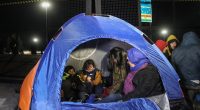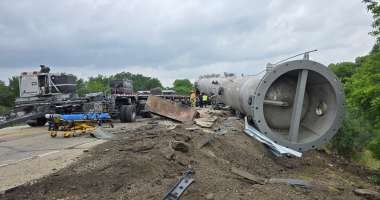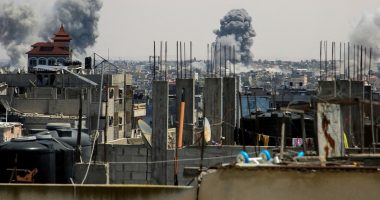
It had been raining for nearly a week when the floodwaters first reached Marcelo Moreira Ferreira’s home in Porto Alegre, the capital of Brazil’s southernmost state, Rio Grande do Sul.
His wife and their four children left to seek shelter with relatives, but Ferreira, 51, wanted to stay: his father had built the modest one-storey structure and he had lived there his entire life.
By morning, however, the muddy water was up to his chest, and he knew he had no choice but to flee.
The house spent nearly a month under the stinking water, polluted by sewage, dead animals, food waste and the fuel from thousands of submerged vehicles.
When Ferreira returned on a recent morning to start cleaning up, a brown stain about 1.8 metrefs (6ft) up the walls still marked the high water mark.
To help mask the stench, he lit some incense. Then he surveyed the ruin: everything his family once owned was in an immense pile of debris in front of the house, waiting for collection.
“I’m afraid the water will rise again, but we came back because it’s the only place we have,” he said.
Ferreira, a Black man, lives in Sarandi, one of the neighbourhoods worst hit by the floods which killed 175 people, displaced hundreds of thousands and left more than a million without essential services such as electricity and drinking water.
And while the damage affected millions, the region’s Black population was hit the hardest: recent research has shown that the areas where the flood waters peaked highest, spread furthest and lingered longest were the ones with the highest proportion of Afro-Brazilian residents.
“People say: ‘The floods hit everyone,’” said geographer Paulo Soares, a researcher for the Observatório das Metrópoles, who participated in the study. “But when we refine the research, we see that – while it did hit everyone in one way or another – it hit some groups harder.”
In Porto Alegre and its surrounding cities, the poorest neighbourhoods – often closest to the rivers and with the worst infrastructure – were the most affected.
“Over the years, urban renewal in downtown Porto Alegre and gentrification in other neighbourhoods have displaced the Black population to areas more susceptible to floods,” Soares said.
Historically, people moved to neighbourhoods such as Sarandi, and the nearby Farrapos, and Humaitá because they were more affordable.
“And they were cheaper because they were flooded during the major flood of 1941,” said Soares.
In 1941, the floods lasted 22 days and inundated 15,000 homes in Porto Alegre. The city’s main river, the Guaíba, swelled to 4.76 metres deep.
That used to be the benchmark for extreme flooding, but this May, all records were broken. More than 300,000 homes were flooded in Porto Alegre alone and the Guaíba reached 5.35 metres on 5 May.
Another recent study showed that human burning of fossil fuels and trees made floods at least twice as likely, while infrastructure failures worsened the damage.
More than 420,000 people are still displaced and 16,000 are living in shelters.
Brazil’s federal government, and the state government of Rio Grande do Sul, have announced aid payments totaling about £1,000 ($1,273) per family to those affected, but for many – including Ferreira – the grants are just a drop in the bucket.
“I work as a house painter. If I don’t work, I don’t get paid, and I haven’t been working for a month. We are surviving thanks to donations. I’m going to the quilombo to pick up food.”
“Quilombo” is a word of Bantu origin that, during the 350 years of slavery in Brazil, referred to communities established by escaped slaves.
Now the word is also used for Black community groups in both rural and urban Brazil. Today, there are about 3,500 self-declared quilombos in the country, including the Quilombo dos Machado, about 500 metres from Ferreira’s home, where local people had come together to distribute donations to affected families.
About 20 volunteers take turns to hand out four meals a day (breakfast, lunch, afternoon snack and dinner), food baskets and mattresses. Donations come from all over the country.
“We are operating 24/7,” said the Quilombo leader, Luiz Rogério Machado, 43, better known as Jamaika.
Serving about 2,500 people a day, the centre has been operating since 2 May and has no plans to close any time soon. “Only when this hell ends,” Jamaika said.
Jamaika said recent history had shown that Brazil’s Black population often bears the brunt of public health crises.
“When the Covid pandemic came, we already knew which population would die … So, with the floods, it wouldn’t be any different. We knew that the most affected would be the Black population on the periphery”
Soares, the geographer, stressed that Rio Grande do Sul’s white citizens were affected, and although the hardest-hit neighbourhoods have a higher proportion of Black people, they are still predominantly white. Wealthier neighbourhoods were also badly affected, as was the majority-white city, Eldorado do Sul.
“But the low-income residents, who are predominantly Black, suffered much more,” said Soares.
The researcher said some people were surprised with the study’s results for a particular reason – not least because Rio Grande do Sul is widely perceived as one of Brazil’s “whitest” regions.
Even Brazil’s president, Luiz Inácio Lula da Silva, said during recent visit that he did not know there are “so many Black people” in the state.
Since the 19th century, waves of German and Italian immigration to the region – part of a government project to “whiten” its population – have had a clear impact on the Rio Grande do Sul’s demographics: 78.4% of its population is white, according to the 2022 census – almost double the national figure of 43.5%.
But there are also 2.3 million Black people – 21% of the state’s population, who are known as gaúchos.
Black gaúchos were responsible for establishing what later became known as Black Awareness Day, which this year will be celebrated for the first time as a national holiday.
It is celebrated on 20 November, commemorating the death in 1695, of Zumbi, leader of the Palmares quilombo, which lasted for almost 100 years in the north-east state of Alagoas – and has become a powerful symbol of resistance against racism in Brazil.
Zumbi’s wife, Dandara, has likewise been seized on as an archetype of Black female inspiration. It is no coincidence that Jamaika and his wife Tamires have chosen Dandara as the name for their daughter who is due to be born this month.
“Dandara was a warrior,” said Jamaika. “My daughter is a Black girl who will be born in the midst of the war of racism in Rio Grande do Sul, so she will have to be a warrior too.”
Read More: World News | Entertainment News | Celeb News
Guardian







